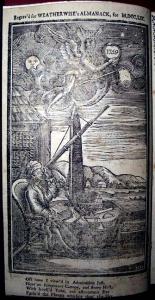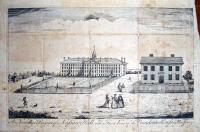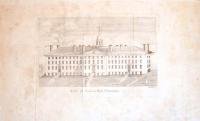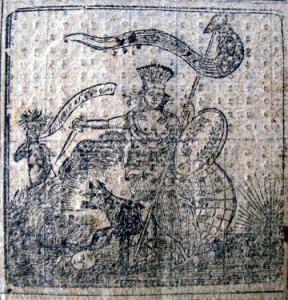HENRY DAWKINS (fl. 1753-ca. 1786) was born in England and originally trained as a silversmith. He took up engraving before emigrating to New York City in 1754. Dawkins found work engraving book-plates, maps, and music first in New York City, then Philadelphia, and again in New York. Dawkins was arrested there in 1776 for counterfeiting paper money, and is last heard of as petitioning Congress for release from jail.


This print shows Nassau Hall at left and the president’s house, now Maclean House, at right. Little is known of William Tennant except that he was the creator for the drawing after which this work was engraved; he is probably the William Mackay Tennent (1744-1810), who graduated from Princeton in 1763.
Connecticut engraver AMOS DOOLITTLE (1754-1832) also began his career apprenticing with a silversmith, but turned to engraving. He work out of a shop in New Haven for over sixty years. His first known attempts are the views of the battles of Lexington & Concord—four plates that he engraved, printed and published in 1775. Doolittle completed more than 600 engravings, including numerous portraits and illustrations for books, music, money, and diplomas, as well as a number of bookplates. He died in New Haven and was buried in Grove Street Cemetery.

Princeton College was first chartered as the College of New Jersey in 1746 and was located at Elizabethtown; but soon moved to Newark where the first commencement was held in 1748. In 1752, the trustees settled on Princeton as the permanent site, and the cornerstone of Nassau Hall was laid in 1754, by architect Robert Smith of Philadelphia.
Finished in 1756, Nassau Hall originally housed the entire College of New Jersey, as Princeton University was then named. Designed by Robert Smith and William Shippen, the building was named for King William III, Prince of Orange, of the House of Nassau. The stone structure has survived bombardment during the American Revolution occupation by troops of both sides during the war, and two fires. George Washington drove the British from Nassau Hall in 1777, and during the later half of 1783, it served as the Capitol of the United States. On August 26th of that year, Washington returned to Nassau Hall to receive the thanks of the Continental Congress for his conduct of the war, and on October 31st news arrived there that the Treaty of Paris had been signed, formally ending the American Revolution.
Read more:
Princeton University Library Chronicle volume 5, p.158 and volume 6, p.153: http://libweb5.princeton.edu/visual_materials/pulc/index.html
Princeton Archives’ Nassau Hall Iconography, 1760-1950: Finding Aid: http://diglib.princeton.edu/ead/eadGetDoc.xq?id=/ead/mudd/univarchives/AC177.EAD.xml
Donald C. O’Brien, Amos Doolittle: Engraver of The New Republic (New Castle: Oak Knoll Press, 2007).
